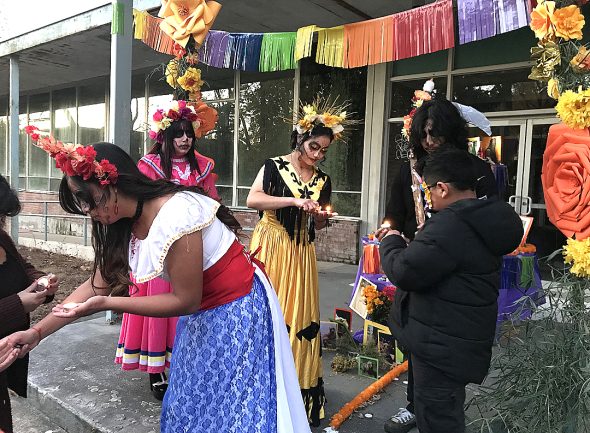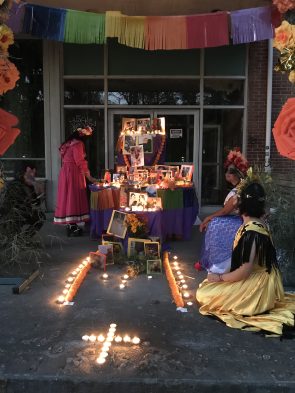
On Thursday, Nov. 2, Antioch College students and several community members gathered on the steps of Main Hall in observance of Día de los Muertos, or Day of the Dead, to pay homage to deceased friends and family members. In honor of the dead, celebrants lit candles, painted their faces as La Calavera and shared tamales and hot chocolate. Attendees also adorned a ofrenda, or altar, with tokens and photos of their loved ones. By the end of the event, the altar was brimming with idiosyncratic objects: potato chips, sodas, baubles, trinkets, poems, CDs and more. (Submitted photo by Steve Bognar)
Honoring the dead on Día de los Muertos
- Published: November 9, 2023
By Paloma Martinez-Cruz and Rosa Ando Martinez
Los Días de los Muertos (Days of the Dead) take place Nov. 1–2 each year. On those days of vibrant celebrations in Mexico and other parts of Latin America, homage is paid to our loved ones who have passed away, and offerings are made for a deeper communion between the living and the dead.
The proliferation of what we know as “Día de los Muertos” celebrations in the United States was spearheaded by Chicano artists and activists in East Los Angeles, California, in the 1970s, and families of Mexican descent throughout the Southwest, but observances and beliefs surrounding the holiday are estimated to be around 3,000 years old.
Rooted in Mexican (Aztec) and other Mesoamerican traditions, Day of the Dead rituals honor death as a natural part of life. Since the 1970s, the spirit of this tradition has gradually spread from Latino families and artist collectives in the Southwest to large-scale celebrations, with Día de los Muertos sugar skulls and colorful decorations now enjoying dedicated displays in mainstream retail stores such as Michael’s and Target.
A quick internet search reveals dates and local areas where festivals and parades celebrating the Día de los Muertos are taking place.
Dedicated rituals honoring the dead can be found in diverse cultures throughout the world. The Japanese Obon celebration and the Chinese Hungry Ghosts days are jubilant ceremonies commemorating ancestors. Since the 11th century, many Scandinavians have been observing All Saints’ on the first Saturday of November, as a time to honor both Christian saints and family members who have departed.
Like the Scandinavians, my family observed Nov. 1 and 2 as All Saints’ and All Souls’ Days in the Christian tradition.
As a Puerto Rican from a Catholic family born and raised in New York, when I moved to East Los Angeles in the 1960s, I began to participate in Muertos celebrations at an important time for Chicano and Latino civil rights movements.
 The day was not only about learning a cultural practice particular to Chicanos in the Southwest — it was also about connecting to the Mexican American community as a fellow Latina and bringing our cultural expressions into public spaces to express pride in our heritage.
The day was not only about learning a cultural practice particular to Chicanos in the Southwest — it was also about connecting to the Mexican American community as a fellow Latina and bringing our cultural expressions into public spaces to express pride in our heritage.
It was a magical night when I first visited Evergreen Cemetery with friends for the Day of the Dead homage in the late 1980s. After dark, the cemetery filled with adults and young children alike for a joyful evening at their family gravesites. We covered the graves with candles and marigold flowers. In warm and welcoming community spirit, food and drinks were shared. Serenading mariachis strolled through the cemetery, adding their music and songs to the night.
At that time, my friend Elodia invited me to her home, where we built and decorated her family altar with flowers, copal incense and photos of the beloved departed. Personal items were included — her father’s hat, her mother’s rosary beads, musical instruments. Pan de muerto (bread of the dead) is especially available in bakeries for these days. Food, drinks, sugar skulls and other offerings were set out.
These were set on the altar as nourishment for the spirits on their journey back to their loved ones on this side of the mortal coil.
It is important to keep in mind the cultural context of Día de los Muertos. Although the skull decorations seem to aesthetically link Día de los Muertos to Halloween in the United States, the symbolism is not meant to be frightening, and it maintains robust ties to indigenous spirituality.
Also, the Catholic celebration of All Saints’ Day takes place Nov. 1 and is followed by All Souls’ Day on Nov. 2. All Saints’ is a celebration of the communion of saints, who are believed to be in heaven through good works and divine grace, while All Souls’ Day is a day to pray for souls in purgatory, who are waiting to get into heaven. Unlike Catholic customs, Muertos inflects these days with different meanings.
Nov. 1 is believed to be the day when young children return to their loved ones, and Nov. 2 is when the adults make the journey back to this side. Also, it is believed that the dead are to be remembered and upheld just as they were; no matter what their offenses or flaws may have been in life, they are to be celebrated and revered, and not viewed through the lens of culpability and deficit that prayers on All Souls’ Day imply.
Above all, the celebration of our Muertos is an expression of deep listening; the voices of our dead tell us to live deeply and courageously, and to always remember where we are from. Even though our departed are no longer with us on the terrestrial plane, the relationship has not ended. They continue to express so many things about what it means to be alive, and they love to be invited to the party!
*Dr. Paloma Martinez-Cruz (daughter) and Rosa Ando Martinez (mother) have been residents of Yellow Springs since 2021. Martinez-Cruz is a professor of Latinx literary and cultural studies and Program Director of Latinx Studies at The Ohio State University. She teaches in the areas of popular culture, performance art, poetry and gender studies.
Rosa Ando Martinez served as liaison to the Latino Community in Los Angeles from the Mayor’s Office, City Hall in the late 1990s, and retired from the Los Angeles Unified School District as a high school counselor at Roosevelt and Venice High Schools. Her contributions to the Chicano Rights Movement (1965–1975) and recent writings have been archived in the Autry Museum of the American West, Aztlan Journal of Chicano Studies and elsewhere.
The Yellow Springs News encourages respectful discussion of this article.
You must login to post a comment.
Don't have a login? Register for a free YSNews.com account.














No comments yet for this article.